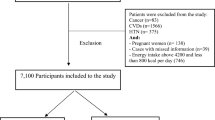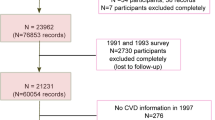Abstract
Background/Objectives:
While type II diabetes (DM) is a major cause of morbidity in the United States, limited data are available on the association between nut intake and incident DM. We sought to examine the association between nut consumption and the risk of DM.
Subjects/Methods:
Prospective cohort of 20 224 male participants of the Physicians’ Health Study I. Nut consumption was estimated using a 19-item brief food frequency questionnaire, and incident DM was ascertained through yearly follow-up questionnaires. Cox regression was used to estimate relative risks of DM.
Results:
The average age of the study participants was 54.4±9.4 years (range: 40.7–87.1). During a mean follow-up of 19.2 years, 1828 cases of DM occurred. The crude incidence rates of DM were 4.82, 4.85, 4.92, 4.16, 4.29 and 3.32 cases per 1000 person-years for individuals reporting nut consumption of rarely/never, <1, 1, 2–4, 5–6 and 7+ servings per week, respectively. While nut consumption was associated with a lower risk of DM in a model adjusted for age (P for tend 0.017), such relation was attenuated on additional control for other confounders (multivariable adjusted hazard ratios (95% confidence interval) for DM were 1.0 (reference), 1.06 (0.93–1.20), 1.10 (0.95–1.26), 0.97 (0.82–1.14), 0.99 (0.76–1.30) and 0.87 (0.61–1.24) from the lowest to the highest category of nut consumption, respectively (P for trend 0.99). No statistically significant association between nut consumption and DM was found in either lean or overweight/obese participants.
Conclusions:
Our data do not show an association between nut consumption and incident DM in US male physicians.
This is a preview of subscription content, access via your institution
Access options
Subscribe to this journal
Receive 12 print issues and online access
$259.00 per year
only $21.58 per issue
Buy this article
- Purchase on Springer Link
- Instant access to full article PDF
Prices may be subject to local taxes which are calculated during checkout
Similar content being viewed by others
References
Albert CM, Gaziano JM, Willett WC, Manson JE (2002). Nut consumption and decreased risk of sudden cardiac death in the Physicians’ Health Study. Arch Intern Med 162, 1382–1387.
Bes-Rastrollo M, Sabate J, Gomez-Gracia E, Alonso A, Martinez JA, Martinez-Gonzalez MA (2007). Nut consumption and weight gain in a Mediterranean cohort: The SUN study. Obesity (Silver Spring) 15, 107–116.
Djousse L, Gaziano JM, Buring JE, Lee IM (2009a). Egg consumption and risk of type 2 diabetes in men and women. Diabetes Care 32, 295–300.
Djousse L, Rudich T, Gaziano JM (2009b). Nut consumption and risk of hypertension in US male physicians. Clin Nutr 28, 10–14.
Izzo R, de Simone G, Chinali M, Iaccarino G, Trimarco V, Rozza F et al. (2009). Insufficient control of blood pressure and incident diabetes. Diabetes Care 32, 845–850.
Jenkins DJ, Kendall CW, Josse AR, Salvatore S, Brighenti F, Augustin LS et al. (2006). Almonds decrease postprandial glycemia, insulinemia, and oxidative damage in healthy individuals. J Nutr 136, 2987–2992.
Jiang R, Jacobs Jr DR, Mayer-Davis E, Szklo M, Herrington D, Jenny NS et al. (2006). Nut and seed consumption and inflammatory markers in the multi-ethnic study of atherosclerosis. Am J Epidemiol 163, 222–231.
Jiang R, Manson JE, Stampfer MJ, Liu S, Willett WC, Hu FB (2002). Nut and peanut butter consumption and risk of type 2 diabetes in women. JAMA 288, 2554–2560.
Josse AR, Kendall CW, Augustin LS, Ellis PR, Jenkins DJ (2007). Almonds and postprandial glycemia—a dose-response study. Metabolism 56, 400–404.
Kochar J, Djousse L, Gaziano JM (2007). Breakfast cereals and risk of type 2 diabetes in the Physicians’ Health Study I. Obesity (Silver Spring) 15, 3039–3044.
Lovejoy JC, Most MM, Lefevre M, Greenway FL, Rood JC (2002). Effect of diets enriched in almonds on insulin action and serum lipids in adults with normal glucose tolerance or type 2 diabetes. Am J Clin Nutr 76, 1000–1006.
Mukuddem-Petersen J, Oosthuizen W, Jerling JC (2005). A systematic review of the effects of nuts on blood lipid profiles in humans. J Nutr 135, 2082–2089.
NIDDK (2008). National Diabetes Statistics, 2007 Fact Sheet. US Department of Health and Human Services, National Institutes of Health.
Parillo M, Riccardi G (2004). Diet composition and the risk of type 2 diabetes: epidemiological and clinical evidence. Br J Nutr 92, 7–19.
Parker ED, Harnack LJ, Folsom AR (2003). Nut consumption and risk of type 2 diabetes. JAMA 290, 38–39; author reply 39–40.
Rimm EB, Giovannucci EL, Stampfer MJ, Colditz GA, Litin LB, Willett WC (1992). Reproducibility and validity of an expanded self-administered semiquantitative food frequency questionnaire among male health professionals. Am J Epidemiol 135, 1114–1126; discussion 1127–1136.
Salvini S, Hunter DJ, Sampson L, Stampfer MJ, Colditz GA, Rosner B et al. (1989). Food-based validation of a dietary questionnaire: the effects of week-to-week variation in food consumption. Int J Epidemiol 18, 858–867.
Scott LW, Balasubramanyam A, Kimball KT, Aherns AK, Fordis Jr CM, Ballantyne CM (2003). Long-term, randomized clinical trial of two diets in the metabolic syndrome and type 2 diabetes. Diabetes Care 26, 2481–2482.
Steering Committee of the Physicians’ Health Study Research Group (1989). Final report on the aspirin component of the ongoing Physicians’ Health Study. N Engl J Med 321, 129–135.
Stein AD, Shea S, Basch CE, Contento IR, Zybert P (1992). Consistency of the Willett semiquantitative food frequency questionnaire and 24-hour dietary recalls in estimating nutrient intakes of preschool children. Am J Epidemiol 135, 667–677.
Tapsell LC, Gillen LJ, Patch CS, Batterham M, Owen A, Bare M et al. (2004). Including walnuts in a low-fat/modified-fat diet improves HDL cholesterol-to-total cholesterol ratios in patients with type 2 diabetes. Diabetes Care 27, 2777–2783.
Torabian S, Haddad E, Rajaram S, Banta J, Sabate J (2009). Acute effect of nut consumption on plasma total polyphenols, antioxidant capacity and lipid peroxidation. J Hum Nutr Diet 22, 64–71.
USDA (2008). Food availability spreadsheet-nuts. http://www.ersusdagov/data/foodconsumption/FoodAvailSpreadsheetshtm#nuts.
van Dam RM (2003). The epidemiology of lifestyle and risk for type 2 diabetes. Eur J Epidemiol 18, 1115–1125.
Welty FK, Lee KS, Lew NS, Zhou JR (2007). Effect of soy nuts on blood pressure and lipid levels in hypertensive, prehypertensive, and normotensive postmenopausal women. Arch Intern Med 167, 1060–1067.
Willett WC, Sampson L, Stampfer MJ, Rosner B, Bain C, Witschi J et al. (1985). Reproducibility and validity of a semiquantitative food frequency questionnaire. Am J Epidemiol 122, 51–65.
Acknowledgements
We are indebted to the participants in the PHS for their outstanding commitment and cooperation and to the entire PHS staff for their expert and unfailing assistance.
Author information
Authors and Affiliations
Corresponding author
Additional information
Contributors: The Physicians’ Health Study is supported by Grant nos CA-34944, CA-40360, CA-097193, HL-26490 and HL-34595, from the National Institute of Health, Bethesda, MD. There are no relationships with industry with respect to this project.
Rights and permissions
About this article
Cite this article
Kochar, J., Gaziano, J. & Djoussé, L. Nut consumption and risk of type II diabetes in the Physicians’ Health Study. Eur J Clin Nutr 64, 75–79 (2010). https://doi.org/10.1038/ejcn.2009.121
Received:
Revised:
Accepted:
Published:
Issue Date:
DOI: https://doi.org/10.1038/ejcn.2009.121
Keywords
This article is cited by
-
Nuts and berries from agroforestry systems in temperate regions can form the foundation for a healthier human diet and improved outcomes from diet-related diseases
Agroforestry Systems (2023)
-
The Mediterranean diet and risk of type 2 diabetes in Iranian population
European Journal of Clinical Nutrition (2019)
-
Consumption of Nuts in the Prevention of Cardiovascular Disease
Current Nutrition Reports (2013)
-
Nuts and Berries for Heart Health
Current Atherosclerosis Reports (2010)



